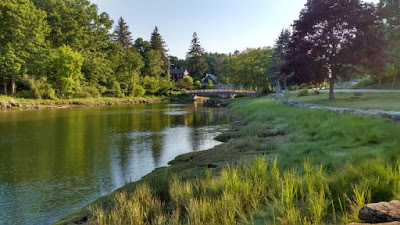Oyster River, New Hampshire: Conflict Between Native Americans and English Settlers in the 1690s
Thomas Chesley: 1644-1697
Thomas Chesley, my eighth-great-grandfather, was born in Oyster
River/Dover, New Hampshire in 1644 to parents Philip Chesley and Elizabeth
Leighton Chesley. Thomas married Elizabeth Thomas in Dover on August 22, 1663.
He was nineteen, and Elizabeth was still in her teens. They had several
children, possibly seven or eight depending on what records are examined. One
of the sons was my seventh great-grandfather Joseph Chesley, born in 1673.
Thomas was a well-respected member of the Oyster River/Durham
community in New Hampshire, serving as selectman in 1688 and again in 1695.
 |
| Colonial era map of Oyster River Settlement |
It is easy to imagine his life as a small-town version of our own lives—living in a community, attending church, patronizing businesses and craftsmen, working his farmland and raising his children. It sounds idyllic. But life in 1690s New Hampshire was far from idyllic. Thomas’ community was at the very edge of the area settled by white settlers. The Oyster River settlement abutted lands used by Native Americans for hunting and farming. The colonists’ lands were acquired through deception, broken treaties and outright theft, which created ill will between the two cultures. This ill will occasionally boiled over into violence.
 |
| Map of entire Pescataway region, approx. 1670 |
The settlement at Oyster River, which included what eventually became the towns of Dover and Durham, New Hampshire, had been the target of native anger for some time, culminating in a raid in 1694 that destroyed between one third and one half of the settlement. Wikipedia sums up the so-called Oyster River Massacre as follows:
“The English settlement of Oyster River was attacked by
Villieu with about 250 Abenaki Indians, composed of two main groups from the
Penobscot and Norridgewock under command of their sagamore Bomazeen (or
Bomoseen). A number of Maliseet from Medoctec took part in the attack. The
Indian force was divided into two groups to attack the settlement, which was
laid out on both sides of the Oyster River. Villieu led the Pentagoet and the
Meductic/Nashwaaks. The attack commenced at daybreak, with the small forts
quickly falling to the attackers. In all, 104 inhabitants were killed and 27
taken captive, with half the dwellings, including the garrisons, pillaged and
burned to the ground. Crops were destroyed and livestock killed, causing famine
and destitution for survivors.”
It is believed the settlement only had three hundred
residents at the time, so one third of the population was killed, with many
others traumatized. While some Chesley family members may have died in the
original raid, Thomas and his family survived. Despite the dangers, they chose
to stay.
But conflicts with the natives continued, and in 1697,
Thomas and a friend were attacked and Thomas was killed. Rev. John Pike wrote
in his journal:
“Nov. 15, 97. Tho: Chesley, sen., slain by ye Indians not
far from Johnsons Creek. Will Jackson taken' at the same time, & at same
time made his escape.”
Johnson’s Creek is a tributary of the Oyster River and was
very near the settlement. Chesley and Jackson were probably out collecting
firewood or hunting, normal daily activities in an area they probably assumed
was safe.
 |
| Johnson's Creek area today on Google Maps with Oyster River at bottom |
Thomas’ estate was probated in January of the following year, with his widow Elizabeth dividing the money from the estate, about 195 pounds, amongst his seven surviving children: Thomas, George (spelled Jorge in the probate files), Joseph, Elizabeth (spelled Elesebeth), Susannah (spelled Sewsanne), Sarah and Mary. The land was divided as follows: (note: the spelling and unusual capitalization directly copies the written text record. There were wide variations in spelling, with even names spelled differently just lines apart. Also note that the women signed with a mark only—they may not have been able to read and write.)
“know all men by thes
present Riting that I Eleseath Chesly Administretres to my Husbands Asteast
Have A greed with my children in devideng what Estete He Left when deseast
which is in maner as folloeth:
To my Soon Thomas
chesly all the Land Seastated Liying and being betwixt Stephen Jonses and
philep Cheslys land AJoyneng to the salt River
To my Soon gorg chesly
all the Land and Houseng and orchet that was my Husbands at the place comamly
called new towen and Half the march that was my Husbands Laying by belemans
Banck Rever and the branches ther of
To my Soon Joseph
chesley fort ackers of Land and A houce situated Lieang and being on the wast
side of oister River frechet and the other Half of Said mairch that Lise by
belemans banck River and the branches ther of
Resarving only the
thards ther of for my yous to Long as I shall Leve
Elesabeth Chesle”
The conflict with the Native Americans continued for another
decade or so. Several of Thomas’ nephews were killed between 1704 and 1708.
However, Thomas Chesley’s descendants continued to live in the Oyster River
area for several additional generations. My seventh great-grandfather Joseph
Chesley and sixth-great-grandfather Thomas Chesley were born and died in the
Durham/Oyster River area. The Chesley’s persistence, along with the growing
numbers of new settlers pushing into the region, helped the colonists prevail
in their conflict with the Native tribes.
Sources:
Rev. John Pike, Journal
of the Rev. John Pike, of Dover, N.H., ed. Rev. A.H. Quint (Cambridge:
Press of John Wilson and Son, 1876
https://en.wikipedia.org/wiki/Raid_on_Oyster_River
Gillette and allied
families : genealogical and biographical / prepared and privately printed
for Mrs. Lewis Singer Gillette.
Publication date 1930 Topics Bent
family, Brown family, Clark family, Gillette family, Hoskins family, Perkins
family, Raymond family. Publisher New
York, N.Y. : The American Historical Society, Inc., 1930.


No comments:
Post a Comment